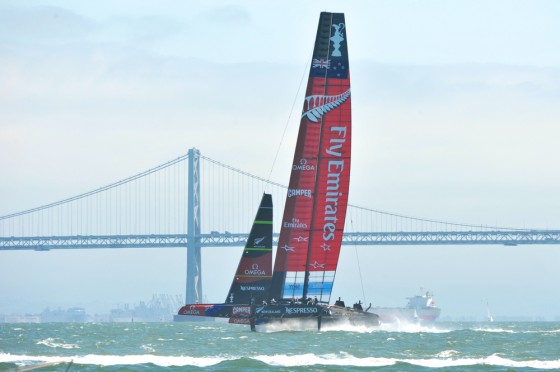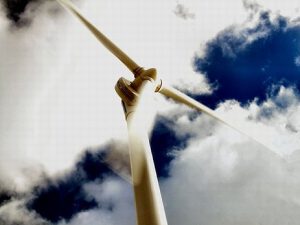
The 2013 America’s cup will be long remembered as one of the closest matches in sailing history and one of the most unlikely comebacks in sporting history when Emirates Team New Zealand came within seconds of securing the America’s cup; but eventually lost when Oracle’s team USA followed a two race penalty and six race losing streak with nine straight wins. These races are over for another four years, but will their cutting-edge wind-powered technology ever make it into the mainstream and score a win for the environment?
The America’s cup yacht race is known for its billionaires and legal controversy as often as it was known as a test of the world’s best sailors. This world’s longest-running sporting tradition goes back to the summer of 1851 when legend has it that when the thirty-meter schooner America beat the Royal Yacht Squadron’s yacht by four minutes, Queen Victoria asked who was second and was told, “Ah your majesty, there is no second.”
While past America’s cup contenders pushed the legal boundaries of the sport and often made for lopsided victories, Larry Ellison’s plan was to bring back one-design racing while simultaneously pushing technological boundaries.
Both Emirates Team New Zealand and Oracle’s Team USA can be congratulated for making this a sporting event worth watching. Like a nautical Cirque du Soleil, the athletic crews danced atop their wind-powered flying machines.
The crew wrestled against six tons of wind power to move the massive sails with every tack and gybe. The amount of human power the grinders could supply limited the sail area for the boat’s maximum wind speed. The twin hulls and thirteen story high sails seemed perilously balanced atop fragile hydrofoil dagger boards.
As a sporting event it couldn’t be better, but why can’t we be so inspired towards other goals such as ending world poverty? What if only a fraction of these vast sums of money invested in this most exclusive of sports were invested in efficiency and environmentalism?
Maybe it isn’t such a stretch to imagine that one day AC-72 hydrofoil catamaran technologies might make it into the mainstream and begin powering ordinary sailboats, ferries, cargo ships and oil tankers. Technology tested in previous Americas cup races such as safety gear, steel, aluminum and composite hulls, winged-sails and even the Australian-designed winged-keel which won the 1983 America’s cup, can be imagined as a predecessor to the hydrofoil dagger-boards of 2013.
These futuristic looking AC-72 catamarans envisioned by Larry Ellison’s team easily outrun many of the oil-powered spectator boats and ferries in San Francisco Bay. In fact the chase boats required to keep up with these beasts require 1200 horsepower outboard motors. Let’s have a quick look at the specifications and capabilities of these yachts:
Class AC-72 Specifications
Type: Catamaran
Length Overall: 86 feet
Length Waterline: 72.2 feet
Mast Height: 131.2 feet
Hull: Carbon Fiber
Daggerboards:Hydrofoil
Weight: A flying 13,000 pounds
Total Sail Area (Fixed wing mainsail plus gennaker): ~6200 sq feet
Mpg: Oil? We don’t need any oil, we’re going back to the future!
So, the AC-72 weighs 13,000 pounds but it almost flies above the water as it sails faster than the wind that powers it, using no oil.
What’s the catch?
First of all, AC-72s are expensive at about $10 million per boat. This high cost reduced the number of competing boats even before the Luis Vuitton elimination races were completed. AC-72s also have a narrow wind envelope. Several of the races were scuttled because the wind was either too light or two heavy. One of Oracle’s AC-72 boats capsized and was destroyed in high winds and Artemis’ AC-72 broke apart in a structural failure which caused the unfortunate death of one of its crew.
These catastrophes led the race committee to set a maximum wind speed of just under 25 knots. If you’ve ever sailed, you’ve probably sailed in more than 25 knots of wind. But the AC-72 doesn’t have the option that even your AMF Sunfish sailboat had when the wind became too strong. The massive fixed-wing sail cannot be lowered or reefed or otherwise reduced in area. If the wind exceeds the maximum safe wind speed, you don’t have many options to stop your boat from doing this:
[youtube]http://www.youtube.com/watch?v=RAGHFr4xzK4[/youtube]
Sailing is an enjoyable pass-time for some and a competitive sport for others, but will it ever be a practical way of moving people and products around our world? It certainly was in the nineteenth century. Sail-powered clipper ships easily outran newer steam-powered ships in the crossed the ocean at an average speed of 19mph.
If that sounds slow, consider this. Because of increased oil prices and recognition of the high cost of bunker fuel pollution, modern cargo ships are averaging only about 20mph. In order to save costs and carbon emissions, some are traveling as slow as 14mph.
Find some video or photos of hydrofoil sailing boats such as the AC-72s, AC-45s and Moths or even venerable clipper ships such as the Cutty Sark. Now look at a “modern” cargo ship or oil tanker and tell me which one looks like the future we should be striving for?
Image of Emirates Team New Zealand’s AC 45 foiling under California’s Oakland Bay bridge from Shutterstock



